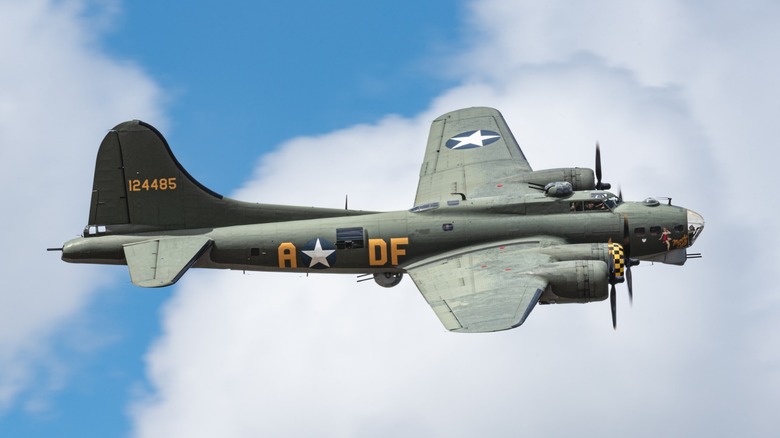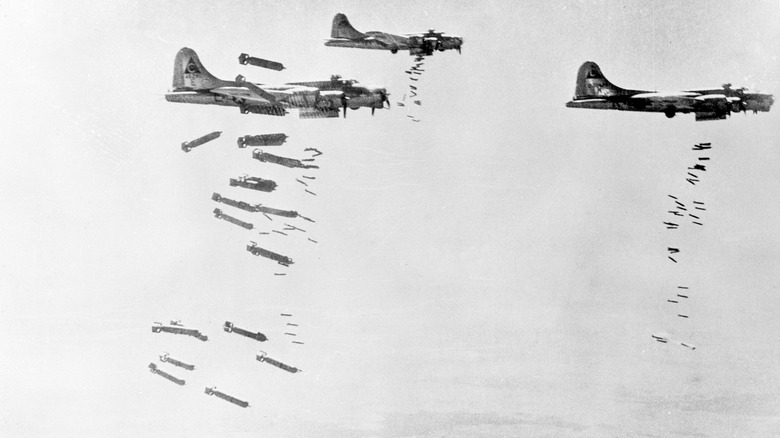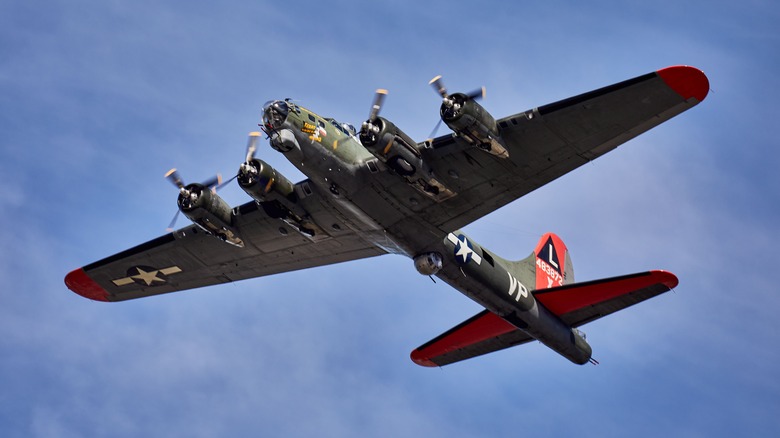How The B-17 Flying Fortress Helped Win World War II
The B-17 Flying Fortress was a workhorse heavy bomber employed by the United States and one of the most legendary planes of World War II. The bomber entered service in the 1930s and continued operating throughout the conflict, ending its production in 1945. Throughout its nine-years in production, Boeing produced 12,726 "Forts," and each one proved useful during WWII, making it one of the most-used bombers of all time behind the B-24.
When the U.S. entered WWII, it had few B-17s in its inventory, but that soon changed as production ramped up considerably in 1942. B-17s were stationed throughout the United Kingdom and Northern Africa, helping the Allies to bomb Axis targets throughout the region. This made it possible for the Americans to fly precision bombing runs in daylight operations, which improved target accuracy at the cost of increased visibility.
As a result, the B-17 was easily sighted and fired upon in most engagements, costing the Americans more than 4,000 aircraft lost to enemy fire. In one bombing raid on Schweinfurt-Regensburg, the Germans shot down 60 Forts. Throughout WWII, many Forts that were shot at and survived required extensive repairs to make them airworthy once more. Despite these complications, the B-17 helped the Allies win WWII.
The B-17's armaments made it deadly to air and land-based targets
The B-17 was one of America's best heavy bombers, and it could carry up to 17,417 lbs. of bombs in a variety of sizes, ranging from 100 lbs. To 2,000 lbs. These could be dropped on targets using the highly classified Norden M-9 bombsight. While incredibly accurate, such devices pale in comparison to modern standards. Regardless, the M-9 made it possible for B-17 bombers to drop ordnance on numerous targets, destroying or disabling them.
The B-17 was no slouch when it came to its own defense, and seeing as it was an easy target for fighters and ground-based anti-aircraft artillery, this was vital. The B-17 boasted a crew of 10 men, including a pilot and co-pilot. Everyone else, including the navigator, engineer, radio operator, and bombardier, was assigned to one of the B-17's seven machine gun emplacements. These included 13 M2 Browning .50 caliber twin tail guns, a waist gun, twin guns in the ball turret, a top turret, a chin turret, and a single cheek gun.
Airmen within used these machine guns to shoot at fighters as a means of defense, and they claimed many German kills throughout the war. The B-17's airborne kill ratio found that they downed 23 enemy planes per 1,000 raids. Unfortunately, despite its many strengths, the U.S. lost thousands of B-17s during WWII. Still, airmen flew them in daring daylight operations, and they achieved numerous successes, helping the Allies win the war and going down as one of the best American planes of WWII.
The B-17 helped gain European air superiority
German flak and fighters brought down thousands of B-17s, leading to 1943 when it became clear that the Allies had to destroy the Luftwaffe to gain air superiority in Europe. This was no easy task, and it demanded a change in strategic bombing doctrine to hit vital production facilities needed to keep the Luftwaffe's Messerschmitt Me-262 and other aircraft flying. These included a ball bearing plant in Schweinfurt-Regensburg and many other places throughout Europe under Operation Argument, also known as the "Big Week."
While B-17s took part in numerous successful raids and managed to pound enemy positions throughout the conflict, perhaps its greatest contribution to the war effort occurred on and leading up to June 6, 1944, otherwise known as D-Day. B-17s meticulously attacked targets in Germany, Austria, and Poland to entice Luftwaffe sorties and destroy factories vital to the German air effort. On D-Day itself, B-17s pounded coastal defenses, enabling the Allied advancement under Operation Overlord.
This helped the Allies gain a foothold in Europe, and according to Robert Oliver of the U.S. Air Force Historical Support Division in an interview with Military.com, "By the time Big Week ended on the 25th, approximately 3,800 sorties by B-17 Flying Fortresses and B-24 Liberators had dropped almost 10,000 tons of munitions, roughly the tonnage dropped by Eighth Air Force during the previous year." These tactics gave the Allies air superiority on D-Day and helped bring the European war to an end the following year.


